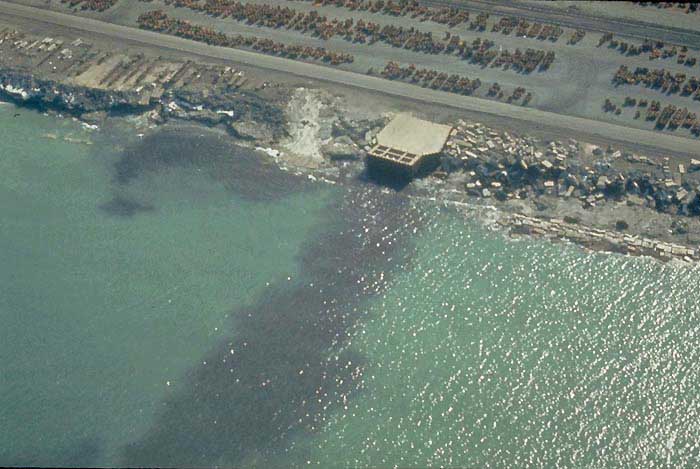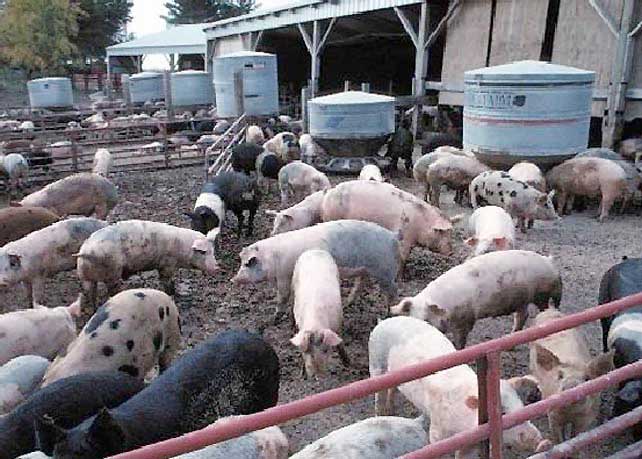Point Source
Pollution Tutorial

Point source pollution is defined by the U.S. Environmental Protection Agency (EPA) as “any single identifiable source of pollution from which pollutants are discharged, such as a pipe...” This image shows a point source of industrial pollution along the Calumet River. Photo: U.S. Environmental Protection Agency, Region V.
The U.S. Environmental Protection Agency (EPA) defines point source pollution as “any single identifiable source of pollution from which pollutants are discharged, such as a pipe, ditch, ship or factory smokestack.”
Factories and sewage treatment plants are two common types of point sources. Factories, including oil refineries, pulp and paper mills, and chemical, electronics and automobile manufacturers, typically discharge one or more pollutants in their discharged waters (called effluents). Some factories discharge their effluents directly into a waterbody. Others treat it themselves before it is released, and still others send their wastes to sewage treatment plants for treatment. Sewage treatment plants treat human wastes and send the treated effluent to a stream or river.
Another way that some factories and sewage treatment plants handle waste material is by mixing it with urban runoff in a combined sewer system. Runoff refers to stormwater that flows over surfaces like driveways and lawns. As the water crosses these surfaces, it picks up chemicals and pollutants. This untreated, polluted water then runs directly into a sewer system.
When it rains excessively, a combined sewer system may not be able handle the volume of water, and some of the combined runoff and raw sewage will overflow from the system, discharging directly into the nearest waterbody without being treated. This combined sewer overflow (CSO) is considered point source pollution, and can cause severe damage to human health and the environment.

These images show the difference between a combined sewer overflow system found in many older cities, and a sewer system where sanitary and stormwater are completely separated. During heavy rains combined sewer overflow systems mix raw sewage with rainwater runoff and discharge it directly into the nearest waterbody without treatment. Photo: Washington DC Water and Sewer Authority.
Unregulated discharges from point sources can result in water pollution and unsafe drinking water, and can restrict activities like fishing and swimming. Some of the chemicals discharged by point sources are harmless, but others are toxic to people and wildlife. Whether a discharged chemical is harmful to the aquatic environment depends on a number of factors, including the type of chemical, its concentration, the timing of its release, weather conditions, and the organisms living in the area.
Large farms that raise livestock, such as cows, pigs and chickens, are other sources of point source pollution. These types of farms are known as concentrated animal feeding operations (CAFOs). If they do not treat their animals' waste materials, these substances can then enter nearby waterbodies as raw sewage, radically adding to the level and rate of pollution.

Large farms that raise livestock are often referred to as concentrated feeding operations (CFOs). These farms are considered potential point sources of pollution because untreated animal waste may enter nearby waterbodies as untreated sewage.
To control point source discharges, the Clean Water Act established the National Pollutant Discharge Elimination System (NPDES). Under the NPDES program, factories, sewage treatment plants, and other point sources must obtain a permit from the state and EPA before they can discharge their waste or effluents into any body of water. Prior to discharge, the point source must use the latest technologies available to treat its effluents and reduce the level of pollutants. If necessary, a second, more stringent set of controls can be placed on a point source to protect a specific waterbody.
Pollution Lessons
- Welcome
- A Brief History of Pollution
- Point Source
- Nonpoint Source
- Urban and Suburban Areas
- Agricultural Operations
- Atmospheric Inputs
- Forestry and Mining Operations
- Marinas and Boating Activities
- Nutrients
- Suspended Sediments
- Pesticides and Toxic Chemicals
- Bacteria, Viruses, and Trash
- Research, Monitoring, and Assessment
- Controlling Nonpoint Source Pollution
- What You Can Do
- References
- Roadmap to Resouces
- Subject Review (PDF)
Categories of Pollution
Pollutants from Nonpoint Sources
